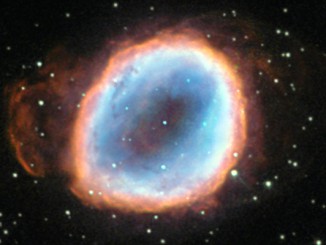
Astronomers measuring how fast the cosmos is expanding in the wake of the Big Bang are still confronted with a baffling conflict between the value observed today and the value derived from observations of the extremely early Universe. Taking dark energy and the acceleration of the cosmic expansion into account, it would appear the modern Universe is flying apart faster than would be expected based on how fast it was moving shortly after the Big Bang.
Using the Hubble Space Telescope and the European Space Agency’s Gaia observatory, researchers calculated a value for the Hubble constant, a measure of the expansion rate of the Universe, of 73.5 kilometres (45.6 miles) per second per million parses. That means that for every 3.3 million light years – 1 million parsecs – farther away a galaxy might be, it is moving away from us 73.5 kilometres per second faster.
The measurement is remarkably precise, with an uncertainty of just 2.2 percent.
But results from ESA’s Planck spacecraft, based on observations of the microwave background radiation, the residual heat left over after the Big Bang, place the value of the Hubble constant at 67 kilometres per second per megaparsec.
While that might seem like generally good agreement for such esoteric measurements, the gap between the Hubble-Gaia data and the Planck measurement is about four times the size of their combined uncertainty. That indicates “a full-blown incompatibility between our views of the early and late-time universe,” Adam Riess, a Nobel Laureate at the Space Telescope Science Institute who helped discover dark energy, said in a statement.
In an email exchange with Astronomy Now, Riess said it is assumed “the Universe expands at the same rate at a given time over the whole Universe.”
“In the present case, the Universe is now expanding faster, even after accounting for dark energy, than our understanding tells us it should based on how it was expanding shortly after the Big Bang,” he said. “Perhaps we should be pleased that we are only off by 9 percent, but since the margin of error is only 2.2 percent, 9 percent is a lot. It says we are missing something.”
The Planck-derived value of the Hubble constant is based on the spacecraft’s precise observations of the cosmic background radiation dating back to within a few hundred thousand years of the Big Bang. Those observations, plugged into the “standard model” of physics, allowed researchers to extrapolate the present expansion rate.
The Hubble-Gaia conclusions were based on a different technique, the direct observation of Cepheid variable stars close to home and in remote galaxies. Cepheids pulsate in a predictable manner that indicates their true brightness. By observing the apparent brightness of a Cepheid in a distant galaxy, astronomers can compute how far away the star must be.
Gaia provided the most accurate data yet on 50 Cepheids in the Milky Way. That allowed the Hubble astronomers to carefully calibrate their observations of extra-galactic Cepheids.
Comparing the positions of those stars and galaxies with the expansion of space as indicated by the red shifting of light from nearby galaxies, Riess’ team was able to derive an outward velocity at different points and from that, the Hubble constant.
“Gaia is the new gold standard for calibrating distance,” said Stefano Casertano of Space Telescope Science Institute. “Gaia brings a new ability to recalibrate all past distance measures, and it seems to confirm our previous work. We get the same answer for the Hubble constant if we replace all previous calibrations of the distance ladder with just the Gaia parallaxes. It’s a crosscheck between two very powerful and precise observatories.”
Riess’ team hopes to reduce the uncertainty in its value for the Hubble constant to less than 1 percent by the early 2020s. Explaining the discrepancy with the Planck data is another matter.
“This is the fifth independent crosscheck of the measurement,” Riess said in the email exchange, “so it does not look like an error.”



